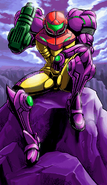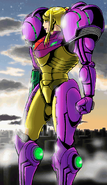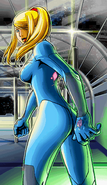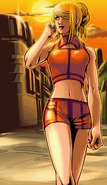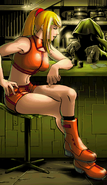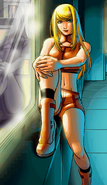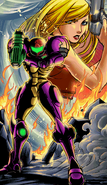m (Bot: Replacing use of deprecated Image: namespace with File: namespace. Article mainspace only.) |
No edit summary |
||
| Line 2: | Line 2: | ||
{{Infobox Game |
{{Infobox Game |
||
| title = Metroid: Zero Mission |
| title = Metroid: Zero Mission |
||
| − | | image = [[File: |
+ | | image = [[File:Mzmpkusf.jpg|240px]] |
| developer = [[Nintendo Research & Development 1|Nintendo R&D1]] |
| developer = [[Nintendo Research & Development 1|Nintendo R&D1]] |
||
| publisher = [[Nintendo]] |
| publisher = [[Nintendo]] |
||
Revision as of 23:29, 28 November 2014
| This article is written from the Real Life point of view |
Metroid: Zero Mission (メトロイドゼロミッション Metoroido Zero Misshon) is a remake of Metroid, making it chronologically the first game in the Metroid series and replacing Metroid in the canon. It was designed to "retell the story of Samus Aran's original mission". [1]
Zero Mission was developed by Nintendo's internal team, Nintendo Research & Development 1, under the direction of Yoshio Sakamoto. Zero Mission features the same plot as the original Metroid, but is slightly modified with the addition of new areas.
Plot
| “ | Planet Zebes...I called this place home once, in peaceful times, long before evil haunted the caverns below. Now, I shall finally tell the tale of my first battle here.... My so-called Zero Mission. | „ |
In the year 20X5 of the Cosmic Calendar, the Space Pirates attacked a deep-space research vessel and seized capsules containing samples of an unknown species that had been discovered on planet SR388. The Space Pirates' objective was to acquire these life-forms; known simply as Metroids, these floating organisms were incredibly dangerous as they could latch onto any other organism and drain its life-energy. Furthermore, it was possible to replicate Metroids in vast numbers by exposing them to beta radiation. The hypothesis that the Metroids were responsible for one of the greatest mysteries in the entire galaxy — the extinction of all life on planet SR388 — was generally accepted as fact.
If the Space Pirates were able to breed the Metroids and use the creatures as biological weapons, the destruction of all galactic civilization would be inevitable. After a desperate search, the Federation Police discovered the Space Pirates' base of operations on the planet Zebes. They launched a full assault on the planet, but the Pirate resistance was strong, forcing the Federation Police to retreat. Meanwhile, in a room hidden deep within the center of the Pirate fortress, the preparations for multiplying the Metroids were steadily progressing.
As a last resort, the Federation Police decided to send a lone bounty hunter to penetrate the Pirate base and destroy Mother Brain, the mechanical life-form that controlled the fortress and its defenses. Samus Aran, considered by many to be the greatest of all bounty hunters, was chosen for the mission. Samus had successfully completed numerous missions that others had thought impossible, making her an excellent candidate. However, despite her accomplishments, much of Samus' true identity remained wrapped in mystery.
Samus Aran eventually landed on the surface of Zebes and began exploring the planet; it was, in fact, the same planet where she had been raised as a child by the Chozo. Eventually, after making it through all of the various caverns and regions of the planet, Samus found and destroyed Mother Brain. However, upon leaving the planet after her successful mission, Space Pirate Fighters attacked her gunship. The ship crash-landed back on Zebes near the Space Pirate Mothership; Samus survived, but her gunship and Power Suit were destroyed, leaving her virtually defenseless.
While searching the Space Pirate Mothership for a way to escape, Samus discovered the nearby ruins of an ancient Chozo temple known as Chozodia. There, she passed the Ruins Test and gained a new and more powerful Power Suit. With her Power Suit restored, Samus returned to the Space Pirate Mothership, where she eventually encountered the Ridley Robot, a mechanized form of Ridley that had taken command of the ship during Ridley's absence. Upon defeating it, Samus was able to successfully escape the planet (and the self-destructing mothership) by using one of the Space Pirate Fighters. All of the Space Pirates' research on Metroids was destroyed in the explosion.
The events of Metroid Prime follow.
General mechanics
Print advertisement.
As a remake of Metroid, Zero Mission's general layout is very similar to the original. However, new items, mini-bosses, and areas have been added, notably Crateria, Chozodia, and the Space Pirate Mothership. The game is also visually similar to Super Metroid. Although Zero Mission can be a linear game, much of it can be completed in a non-linear fashion via Sequence Breaking making it possible to complete the game by collecting as little as 9% of all items. As with most Metroid games, the player can save in Save Rooms and can open a map to help with navigating around the planet.
Zero Mission also differs from the original Metroid and the other Metroid games in that the player can play as Samus without her Power Suit, making her more vulnerable to damage. This form is known as Zero Suit Samus. This marks the second time (the first was in the first Metroid) she has been playable during the course of normal game play without her suit, whereas in each previous Metroid game, seeing Samus without her armor has been a feature in one or more of the game's endings or an easter egg.
Unlockables
- If Zero Mission is cleared on any mode, a reproduction of the original Metroid is unlocked.
- If Normal mode is completed, then Hard mode is unlocked for the next play session. In Hard mode, damage taken is doubled, enemies are often multiplied or replaced with tougher versions of themselves, and upgrades are less effective -- Energy Tanks only add 50 energy to Samus' total instead of 100, normal Missile Tanks add 2 rather than 5 Missiles, and Super Missile Tanks and Power Bomb Tanks add just a single of each to Samus' supply. Additionally, there are some minor map changes, most notably the removal or blockage of certain Save Rooms.
- If Zero Mission is cleared on Hard mode, a Sound Test feature is unlocked.
- If Zero Mission is connected to Metroid Fusion, it unlocks a gallery showcasing many images of Samus from Metroid Fusion that were only available in the Japanese version of Fusion. Also, images of her past are displayed graphically telling her story from the raid of K-2L, her home planet, to her training with the Chozo.
- If a player presses Up, Left, Right, Down on the Start Game option of a file that has beaten Normal mode, he or she unlocks Time Attack Mode, which is set on Normal difficulty but will save the best time for clearing the game when using this setting. Time Attack is also available for Hard mode; if you start a new game on the Hard difficulty, exit it, then enter the Time Attack code, you can do a time attack on Hard.
- If Time Attack Mode is cleared, a menu is unlocked that will display the best Time Attack times for both 100% cleared and less than 100% cleared.
Trivia
- This game has a prequel manga depicting Samus' childhood, as well as some of Samus' history in the Federation and a small rendition of the game's events. It has been fan-translated into English.
- Metroid: Zero Mission's code contains a left-out Crocomire sprite which has ambient animations but is incapable of moving, attacking, or taking damage. It is unfinished and has no death animations, indicating that it was going to be included but was later dropped. It is notable that this rendition of Crocomire does not have its signature rough skin, possibly indicating that the injury was intended to be inflicted in this game.
- In Metroid Fusion, Samus mentions that the Etecoons and Dachoras had taught her maneuvers she didn't know she had, but she is able to use these abilities all the way back to the remake of the first game.
- Metroid: Zero Mission is the first game that has part of the story take place while playing without the Power Suit (discounting the original Metroid, which had the Justin Bailey as an unlockable cosmetic variant).
- Metroid: Zero Mission and the Metroid Prime Trilogy are the only remakes in the Metroid series.
- Two features have been found in the game's code. The first is the ability to toggle items on and off, much like Super Metroid (though the suits cannot be disabled, and the Bombs and Power Bombs can only be disabled when the Morph Ball is). The second is that Red Blast Shields take five Missiles to open instead of the single Missile required in the final version of the game. The ability to toggle the items on and off can be used with a cheating device or hacking.
- There is a microgame based on the game in WarioWare D.I.Y., simply called "Metroid".
- The game makes a cameo appearance in an episode of House M.D. titled "Occam's Razor", where House can be seen playing it during several parts of the episode. Notably, the sound effects are different, possibly due to copyright issues. There are mentions of "Level 4" and "space bunnies", and apparently turning into the Morph Ball in a Chozo Statue's hand causes the player to lose.
Areas
- Brinstar
- Kraid
- Norfair
- Ridley
- Tourian
- Crateria (This area was not available in the original NES Metroid.)
- Chozodia (only accessible after defeating Mother Brain. This area was not available in the original NES Metroid.)
- Space Pirate Mothership (only accessible after defeating Mother Brain. This area was not available in the original NES Metroid.)
See also
Gallery
References
- ^ Yoshio Sakamoto's opening monologue, during an interview sanctioned by Nintendo. Harris, Craig, "Metroid: Zero Mission Director Roundtable", IGN. Accessed on July 9, 2005.

